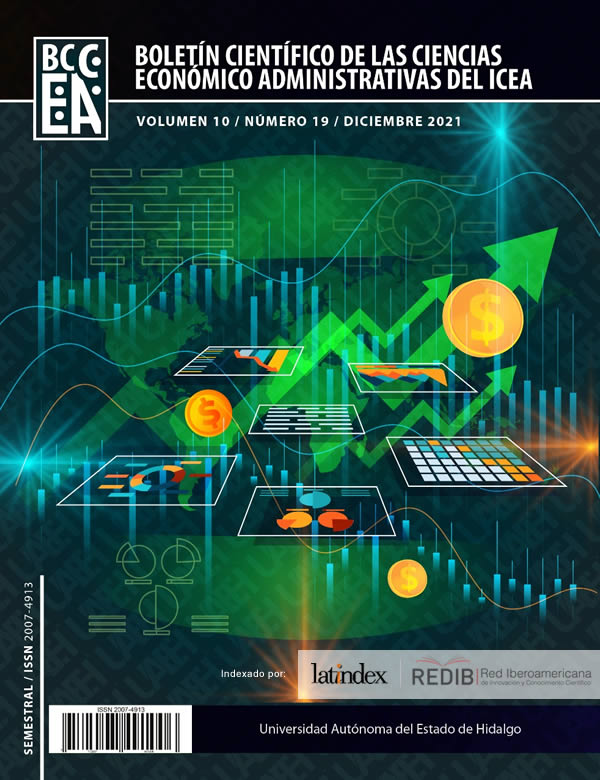A Comparison of the Labor Reform of 2012 and 2019
Abstract
This paper it makes a comparison between the reform to the Federal Labor Law of 2012 and that of 2019 in order to analyze if the 2019 reform´s main goal is focused at correcting the exacerbation of job insecurity that the 2012 reform may have caused. To achieve this target, the objectives of both reforms are studied and a brief evaluation of the 2012 reform is made. It shows that the 2019 reform does not intend to make the labor market even more flexible as its predecessor. In contrast to the 2012 reform, among the main objectives of the 2019 reform are to strengthen unions and regulate outsourcing.
Downloads
References
Ross, J. B. (2013). Algunas tesis equivocadas sobre el estancamiento económico en México. México: Fondo de Cultura Económica.
Aspe, P. (1992). El Camino Mexicano de la transformación Económica. México: SHCP.
Chiquiar, D., & Ramos-Francia, M. (2009). Competitividad y Crecimiento de la Economía Mexicana. Documentos de Investigación Banco de México, 90. Obtenido de: https://www.banxico.org.mx/publications-and-press/banco-de-mexico-working-papers/%7BBC54B22F-FA99-43B7-4769-03208864F57C%7D.pdf
Levi, S. (2008). Buenas Intenciones, Malos Resultados, Política Social, Informalidad y Crecimiento Económico en México. Brookings InstitutionPress. Obtenido de: http://sgpwe.izt.uam.mx/files/users/uami/gma/mexicana/Levy_2008_Resumen.pdf
Secretaría de Gobernación. (2013). Reforma laboral, derecho del trabajo y justicia social en México. México DF. [5] Cañete-Villafranca R, Guillem D, Brito-Pérez K. Paternalismo médico. Rev. Med. Elect. 2013;35(2):144–152. Obtenido de: http://gaceta.diputados.gob.mx/Gaceta/64/2021/abr/20210413-V.html
Díaz Pérez, D., Molano, M., & Piñeiro, A. (2020). Diagnóstico IMCO: La subcontratación y sus implicaciones en México. CDMX: Instituto Mexicano para la Competitividad (IMCO). Obtenido de: https://imco.org.mx/wp-content/uploads/2020/02/20200211_DIAGN%C3%93STICO-IMCO_LA-SUBCONTRATACI%C3%93N-Y-SUS-IMPLICACIONES-EN-M%C3%89XICO_DOCUMENTO.pdf
Instituto Nacional de Estadística y Geografía. (2021). Personal ocupado subcontratado en las unidades económicas: outsourcing: Censos Económicos 2019. México. Obtenido de: https://www.inegi.org.mx/contenido/productos/prod_serv/contenidos/espanol/bvinegi/productos/nueva_estruc/702825198671.pdf
Martínez, J., y Cabestany, G. (13 de Noviembre de 2020). Reforma de AMLO para "poner orden" en el outsourcing. La Jornada.
Instituto Belisario Domínguez del Senado de la Republica. (2014). Valoración Inicial Sobre los Efectos de la Reforma Laboral 2012.
Nolasco, A., y García, J. (2014). Los Periodos de Prueba o Capacitación Inicial en los Contratos de Trabajo, Implementados a Partir de la Reforma Laboral 2012, son Violatorios de Derechos Humanos. Puebla de Zaragoza: Benemérita Universidad Autónoma de Puebla.
Banegas, I., Hernández, T., y Gómez, A. (2020). Determinantes de la Formalización Laboral en México en el período 2010-2016. Organización Internacional del Trabajo.
Cabrera, S. (2015). Las Reformas en México y el TLCAN. Revista Problemas del Desarrollo, 46(180), doi: 10.1016/S0301-7036(15)72120-6
Anguiano Orozco, A., y Ortiz Magallón, R. (2013). Reforma Laboral en México Precarización Generalizada del Trabajo. El Cotidiano, 95-104.
Martínez, J., y Cabestany, G. (2016). Diseño e Implicaciones de la Reforma Laboral de 2012. Reformas Estructurales: Avances y Desafíos.
Colmex. (2018). Desigualdades en México 2018. México: El Colegio de México, A. C. Obtenido de https://desigualdades.colmex.mx/informe2018
DOF. (2019). Reforma a la Ley Federal del Trabajo. Poder Ejecutivo y Secretara de Trabajo y Previsión Social. Obtenido de: https://www.dof.gob.mx/nota_detalle.php?codigo=5559130&fecha=01/05/2019
Guerra, P., Ortiz, A., & Barragán, J. N. (2019). Análisis de la Nueva Reforma ALboral en México. Universidad Autónoma de Nuevo León.
Ávila, J. (17 de Noviembre de 2020). Lo bueno y lo malo de la reforma al sistema de outsourcing en México. Expansión
Flores, Z. (14 de abril de 2021). ¿Cuáles son los cambios que verás con la reforma sobre outsourcing? El Financiero.
De la Garza De Vecchi, G. (3 de Diciembre de 2020). Reforma en subcontratación laboral, ¿un cambio necesario? Obtenido de Deloitte












